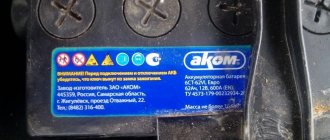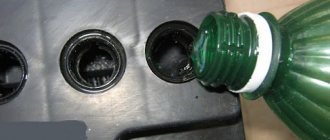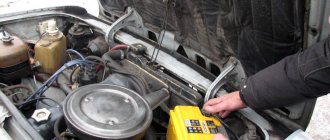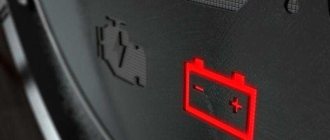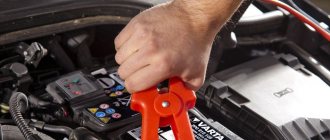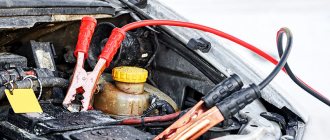The problem of timely battery replacement is especially pressing for all car owners, but most often buyers of used cars receive an unexpected surprise. In the warm season, problems with the battery usually do not arise: the equipment starts up obediently. But as soon as winter comes, the picture changes, and the battery can easily fail the car owner at the most inopportune moment. However, few people know that you can figure out for yourself when you need to change the battery in your car. How to predict a “surprise”?
My time has come
How long should a battery last? My record from the Zhiguli era is nine years. The service life of modern batteries in current conditions largely depends on the nature of travel, weather conditions and the condition of the car, but the average is known: 4–5 years. Is your battery this age? Then get ready for replacement. There is another way to predict the future of the battery: you need to focus on the mileage of the car. On average, according to observations of the cars of the editorial fleet, it is about 100,000 km. And if, moreover, winter is ahead, then a replacement will be justified.
How to check if the battery needs to be replaced
The only clear indications of the need to replace a car battery are damage to the case, destruction or short circuit of the plates. Otherwise, you can try to extend the battery life by trying to charge it and testing it. To make a preliminary assessment of the wear of a car battery before testing, you need to:
- Measure voltage
.
On a working battery with a normal residual life, it should be no lower than 12.6 V
when measured 3 hours after charging.
Lower values indicate critical wear, and if the voltage does not reach 11 V
, then there is
a possibility of a short circuit
in one of the cells. - Check the density of the electrolyte
.
Normally, on a serviceable, charged battery, it should be about 1.27–1.28 g/cm3
at room temperature. You can also check the density on a discharged battery, but then to assess its condition you need to compare the obtained values with the tabulated ones. The normal dependence of density on temperature and charge is shown in the illustration. - Check electrolyte level
.
Normally, the electrolyte should have a level 1.5–2 cm above the edge
of the plates. Many batteries have level marks inside the service holes; in some models it is displayed using a float indicator. If the level is below normal, it can be restored with distilled water. - Check sulfation
.
In serviceable batteries with plugs, by unscrewing them, you can visually inspect the plates. Ideally, in a charged state, they should not have a light gray coating
, a small amount is acceptable, but deposits over most of the area indicate a high degree of wear on the car battery.
You can reliably identify the wear of car batteries using diagnostic equipment or tests.
Test 1: Normal load test
It is not always possible to find out the remaining life of a battery only by external signs and voltage. A more correct approach is load testing. The easiest way to identify a dying battery is to load it with standard electrical appliances. For the test you need:
- After recharging or a long trip, wait 1–2 hours until the voltage on the battery normalizes.
- Turn on the headlights.
- Wait about 30 minutes.
- Start the engine again.
If the battery is still in good condition and the engine is in order, then it will start on the first try, the starter will turn vigorously. If the battery is worn out, starting will be difficult (or completely impossible) and you should hear the starter working “in tension”, its speed sags.
Test 2: Load Fork Test
You can quickly determine that it is time to change the battery using a load fork. The test is carried out on a charged battery in the following order:
Battery test with a load fork: video
- Connect the load plug with the unloaded terminal and measure the open circuit voltage (OCV).
- Connect the load plug with the second terminal and measure the voltage under load with a high current.
- Keep the plug connected for about 5 seconds and monitor the voltage changes on its scale or screen.
In good condition, a charged battery should produce 12.6–13 V without load. After connecting the plug, the voltage will drop and the degree of wear can be approximately assessed by the amount of drawdown. On a fully operational 55–75 A*h car battery, there should be a drop of at least 10.5–11 V.
If the battery is “tired”, but still suitable for work, then the voltage in the load will be 9.5–10.5 V. If the values fall below 9 V, then such a battery will soon have to be replaced.
The nature of the change in readings is the second indicator of wear. If under load the voltage on the device is stable or even increases slightly, then the battery is working. A constant decrease in voltage indicates that the battery is already worn out and cannot support the load.
Test 3: Load capacitance measurement
Battery capacity is measured in Ah and is indicated on the battery. This value is obtained by discharging the battery with a load of 0.05C or 5% of the rated capacity, that is, 2.5 A for 50 Ah or 5 A for 100 Ah. It is necessary to charge the battery, and then proceed in the following order:
- Measure the NRC of a battery that has been charged and left for several hours.
- Connect a load of appropriate power of 0.05C (for a car battery, a 12 V light bulb up to 30–40 W is suitable).
- Leave the battery under load for 5 hours.
- Disconnect the load, wait a few minutes for the NRC to stabilize and measure it to assess the degree of charge of the battery by voltage.
- Determine the discharge percentage. For example, if the battery voltage level is 70%, then a fully charged battery is discharged by 30%.
- Calculate the residual capacity using the formula Res.=(load in A)*(time in hours)*100/(percentage of discharge).
If the battery is discharged to a voltage below 11.5 V at this stage, the result is already clear: its resource is exhausted!
If the lamp consumes 3.3 A, and a battery with a capacity of 60-65 A_h is discharged by 40% in 5 hours, then Comp. = 3.3_5_100/40 = 41.25 A_h, which indicates the presence of noticeable, but still acceptable wear. Such a battery will work, but starting difficulties may occur only in severe frost.
In some cases, the battery capacity, which has fallen due to sulfation of the plates, can be slightly increased using several charge-discharge cycles with low current or in pulse mode, available in a number of models of automatic chargers.
Test 4: Internal Resistance Measurement
Another way to understand that a car battery is dying is to measure the internal resistance of the battery.
Checking the battery with a professional Fluke BT510
This can be done by direct and indirect methods:
- Straight
. A special tester is used, amateur (for example, YR1035) or professional (for example, Fluke BT510), which directly indicates the value of internal resistance. - Indirect
. The amount of internal resistance is determined by the voltage drop at a known load.
A serviceable and charged lead-acid battery, when tested with a tester, should show an internal resistance of about 3–7 mOhm (0.003-0.007 Ohm). The larger the capacity, the lower the value should be. A doubling of the value indicates that the resource has been depleted by approximately 50%.
To indirectly calculate resistance, you will need a multimeter or voltmeter and a load with a known current consumption. A 60W car bulb is best.
How to check battery life by calculating resistance:
- The NRC is measured on a charged and cooled battery.
- A load is connected to the battery and held until the voltage stabilizes - usually about a minute.
- The battery voltage under load is measured.
- The magnitude of the drop in the NRC (ΔU) is calculated.
- The resulting ΔU value is divided by the load current (I) (5 A for a 60 W lamp) to obtain the resistance value using the formula Rpr.=ΔU/ΔI. ΔI will be equal to 5 A for a 60 W lamp.
- The theoretical internal resistance of the battery is calculated by dividing its rated voltage by the specified starting current using the formula Rtheor.=U/I.
- The theoretical value is compared with the practical value and the condition of the battery is determined from their difference. If the battery is working properly, then the lag between the actual result and the theoretical one will be small.
If the voltage drops sharply below 12 V, does not stabilize and constantly decreases even under light load, the wear of the battery is already obvious even without further tests.
Calculation of internal battery resistance: video
For example, let’s take a 60 A*h battery with a starting current of 600 A, charged to 12.7 V. Its theoretical resistance Rtheor.=12.7/600=0.021 Ohm or 21 mOhm.
If before the NRC it was 12.7 V, and when measuring after the load - 12.5 V, in the example it will look like this: Rpr.=(12.7-12.5)/5=0.04 Ohm or 40 mOhm . Based on the measurement results, it is possible to calculate the starting current of the battery, taking into account wear according to Ohm’s law, that is, I = 12.7/0.04 = 317.5 A (from the factory 600 A)
If before the measurements the voltage was 12.65 V, and after - 12.55, then Rpr. = (12.65-12.55)/5 = 0.02 Ohm or 20 mOhm. This converges with the theoretical 21 mOhm, and according to Ohm’s law we get I = 12.67/0.021 = 604 A, that is, the battery is in ideal condition.
Another way to calculate the internal resistance of a battery is by measuring its voltage at two different loads. It is presented on video.
Detrimental lifestyle
The voltage and density are normal, the generator is working, there is no mechanical damage, but the battery still dies a couple of weeks after the test - why? The specifics of driving in a modern metropolis often help destroy a working battery. A cold, energy-consuming start in the morning, then a sluggish crush in city traffic jams with all consumers turned on (headlights, wipers, heated windows and seats, ventilation). In the evening everything repeats itself. In this mode, the battery receives less energy from the generator than it gives out. Moreover, in the cold it does not accept a charge until it warms up, and therefore is constantly discharged, receiving almost nothing in return. The worst situation is for cars with an external battery: there is no one and nowhere to warm the poor thing. Such a battery, even if it is completely new, needs to be removed from the car from time to time and recharged.
Have a nice trip and good charge!
- How long will the battery last without recharging? We did an experiment and this is what we found out.
- If there is an opportunity not to change the battery, but simply charge it, it is worth taking advantage of it. Battery chargers, lighting cables and other winter assortment are in our store.
Photo: depositphotos.com
Symptoms of a dying battery - when to look under the hood
Signs of battery wear on a car usually appear most clearly when the engine starts and when the load on the on-board network increases . Some of them may indicate either the exhaustion of the battery life itself, or simply a drop in the charge level due to a malfunction of the generator or increased energy consumption caused by improper operation of the equipment.
The main symptoms of a dying car battery:
Symptoms of a tired battery using the example of Lada Vesta: video
- the starter has difficulty moving the flywheel, especially at low temperatures, the speed clearly slows down when the key or start button is held for more than 2-3 seconds;
- The brightness of the headlight lamps and interior lighting drops significantly when the engine is turned off, and after the start it increases abruptly;
- the battery goes to zero after 12 hours of parking;
- The idle speed drops when additional consumers are turned on, and when the air conditioner is turned on, the engine sometimes stalls;
- turning on the consumer (dimensions and headlights, audio system, compressor for inflating wheels) while parked with the engine turned off causes a noticeable drop in battery voltage;
- When the engine is off, the windshield wipers, windows and power sunroof move too slowly and with difficulty.
If you notice the symptoms described, you need to look under the hood and inspect the battery . The obvious signs of battery failure and their causes are listed in the next section.
Battery swelling
Some signs of a bad battery can be identified by simply visually inspecting the device. Body bloating is one of them. Chemical reactions are constantly happening inside the battery. For their implementation, optimal conditions must be observed, especially regarding temperature.
Exposure to heat and frost has a bad effect on the electrolyte located in the battery jars (cells):
- when overheating occurs inside the battery, excessive gas formation occurs, which swells the case;
- in severe frosts, the liquid hardens and deforms the body (subject to long periods of inactivity on the street or in an unheated garage).
A swollen case is a clear sign of a dead battery. There is no way to save him.
And they don't arrive on schedule!
Has it ever happened to you that when you got into a car in the hope of getting somewhere, you discovered that instead of a “spirited” start, only a faint whine of the engine awaited you? For those who understand something about the structure of a car, this is a sure sign that the battery is discharged, since it is the one that supplies the charge of electricity necessary to power all the electrical appliances of the car.
To avoid finding yourself in a similar situation, you need to be able to independently determine and anticipate when the battery will fail.
Signs that replacement is needed
Experts note the following signs that the battery needs to be replaced:
- Insufficient battery charge. During a short stay (no more than 24 hours), the battery does not maintain the required capacity and does not provide the starting current necessary to start the engine. The residual voltage on the battery, measured with a multimeter after parking, is less than 12.2 Volts (all consumers are turned off).
- The process of electrolyte boiling when charging with a current of less than 3 Amps.
- Significant reduction in starting current when the battery is fully charged. Measurements are made using a load fork.
- Failure to reach the green zone after charging the battery (in a battery with a visual inspection window).
- A decrease in the electrolyte level of a maintenance-free battery below a critical level.
- Loss of tightness of the battery structure.
- Change in battery geometry (swelling, distortion).
- Visible shedding of plates (battery in a translucent case).
If the listed signs are present, then a situation arises when it is time to change the battery.
If the battery no longer holds a charge, this is a sign to replace it.
Main causes of battery death
The list of main reasons includes:
- Sulfation. Violation of battery operation rules, prolonged downtime, incomplete or irregular charging, low level of conductive liquid in jars are the reasons why crystalline lead sulfate begins to form on the lattice plates. This process is called sulfation. The presence of lead sulfate interferes with chemical reactions inside the battery, causing its damage.
- Regular short circuits. Micro-circuits contribute to the shedding of the active substance from the surface of the plates into the electrolyte. Because of this, the conductive liquid begins to heat up, which leads to a decrease in its density. Signs of a closed battery may not appear immediately, but as the negative effect accumulates, other symptoms of a dead battery will appear: dark color of the electrolyte, clicking of the starter relay, problems with the auxiliary systems of the car.
- Oxidation of terminals. During driving, the electrolyte may leak or evaporate, leaving traces of oxides at the contact points. Timely cleaning of the terminals will prevent the battery from running out, otherwise the battery will quickly discharge and become unusable.
Other reasons for battery damage: foreign substances entering the electrolyte, interruption of the current transmission circuit, incorrect connection to the rectifier, regular recharging.
Auto auxiliary systems do not work
The battery powers the auxiliary modules of the machine when the engine is turned off. This includes headlights, power windows, climate control, multimedia, security units and other related systems. When the battery is dead or in a severely discharged state, these modules begin to malfunction or do not work at all. Typical manifestations of battery problems:
- faded headlights;
- slow windows;
- switchable air conditioner;
- weak response to turning on the security mode;
- faulty radio (turns off on its own when the volume is increased or the mode is switched).
This behavior may be due to poor contact at the battery terminals; in this case, the symptoms will spontaneously appear and disappear. When the presence of such problems is observed constantly and in complex, then we can judge the exact malfunction of the battery.
Putrid smell from battery cans
If any problems arise, foreign, unpleasant odors may appear inside the battery. Possible causes of a putrid odor include:
- plate closure;
- recharge;
- freezing or overheating of the electrolyte.
All these malfunctions entail the release of gas, which smells like rotten eggs. At the initial stages, the aroma will come only from under the hood, and as the situation worsens, it will begin to appear in the car’s interior.



